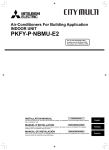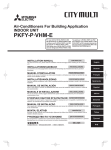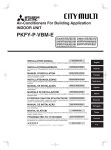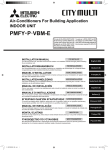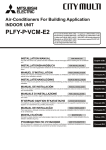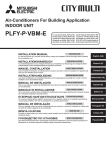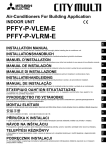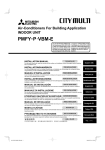Download Mitsubishi Electric PKFY-P.VBM-E Installation manual
Transcript
Air-Conditioners For Building Application INDOOR UNIT PKFY-P·VBM-E INSTALLATION MANUAL FOR INSTALLER For safe and correct use, please read this installation manual thoroughly before installing the air-conditioner unit. INSTALLATIONSHANDBUCH FÜR INSTALLATEURE Zum sicheren und ordnungsgemäßen Gebrauch der Klimaanlage das Installationshandbuch gründlich durchlesen. MANUEL D’INSTALLATION Português (P) MONTÖR İÇİN Emniyetli ve doğru biçimde nasıl kullanılacağını öğrenmek için lütfen klima cihazını monte etmeden önce bu elkitabını dikkatle okuyunuz. РУКОВОДСТВО ПО УСТАНОВКЕ Ελληνικά (GR) PARA O INSTALADOR Para segurança e utilização correctas, leia atentamente este manual de instalação antes de instalar a unidade de ar condicionado. MONTAJ ELKİTABI Italiano (I) ΓΙΑ ΑΥΤΟΝ ΠΟΥ ΚΑΝΕΙ ΤΗΝ ΕΓΚΑΤΑΣΤΑΣΗ Για ασφάλεια και σωστή χρήση, лαρακαλείστε διαβάσετε пρоσεχτικά αυτό το εγχειρίδιο εγκατάστασης пριν αρχίσετε την εγκατάσταση της μονάδας κλιματισμού. MANUAL DE INSTALAÇÃO Español (E) PER L’INSTALLATORE Per un uso sicuro e corretto, leggere attentamente questo manuale di installazione prima di installare il condizionatore d’aria. ΕΓΧΕΙΡΙΔΙΟ ΟΔΗΓΙΩΝ ΕΓΚΑΤΑΣΤΑΣΗΣ Nederlands (NL) PARA EL INSTALADOR Para un uso seguro y correcto, lea detalladamente este manual de instalación antes de montar la unidad de aire acondicionado. MANUALE DI INSTALLAZIONE Français (F) VOOR DE INSTALLATEUR Voor een veilig en juist gebruik moet u deze installatiehandleiding grondig doorlezen voordat u de airconditioner installeert. MANUAL DE INSTALACIÓN Deutsch (D) POUR L’INSTALLATEUR Veuillez lire le manuel d’installation en entier avant d’installer ce climatiseur pour éviter tout accident et vous assurer d’une utilisation correcte. INSTALLATIEHANDLEIDING English (GB) Türkçe (TR) ДЛЯ УСТАНОВИТЕЛЯ Для осторожного и правильного использования прибора необходимо тщательно ознакомиться с данным руководством по установке до выполнения установки кондиционера. Русский (RU) Contents 1. Safety precautions..................................................................................... 2 2. Installation location .................................................................................... 2 3. Installing the indoor unit ............................................................................ 3 4. Refrigerant pipe and drain pipe ................................................................. 4 5. Electrical work ........................................................................................... 6 6. Test run...................................................................................................... 7 Note: The phrase “Wired remote controller” in this installation manual refers only to the PAR-21MAA. If you need any information for the other remote controller, please refer to either the installation manual or initial setting manual which are included in these boxes. 1. Safety precautions : Indicates an action that must be avoided. Before installing the unit, make sure you read all the “Safety precautions”. Please report to your supply authority or obtain their consent before connecting this equipment to the power supply system. : Indicates a part which must be grounded. Warning: Describes precautions that must be observed to prevent danger of injury or death to the user. : Indicates that caution should be taken with rotating parts. Caution: Describes precautions that must be observed to prevent damage to the unit. : Beware of electric shock. After installation work has been completed, explain the “Safety Precautions,” use, and maintenance of the unit to the customer according to the information in the Operation Manual and perform the test run to ensure normal operation. Both the Installation Manual and Operation Manual must be given to the user for keeping. These manuals must be passed on to subsequent users. GB : Indicates an important instructions that must be followed. Warning: • Ask the dealer or an authorized technician to install the air conditioner. • Install the unit at a place that can withstand its weight. • Use only specified cables for wiring. The wiring connections must be made securely with no tension applied on the terminal connections. Also, never splice the cables for wiring (unless otherwise indicated in this document). Failure to observe these instructions may result in overheating or a fire. • Use only accessories authorized by Mitsubishi Electric and ask the dealer or an authorized technician to install them. • Do not touch the heat exchanger fins. • Install the air conditioner according to this Installation Manual. • Have all electric work done by a licensed electrician according to local regulations. Caution: • Do not use the existing refrigerant piping, when use R410A or R407C refrigerant. • Use ester oil, either oil or alkylbenzene (small amount) as the refrigerator oil to coat flares and flange connections, when use R410A or R407C refrigerant. • Do not use the air conditioner where food, pets, plants, precision instruments, or artwork are kept. • Do not use the air conditioner in special environments. • Ground the unit. : Indicates that the main switch must be turned off before servicing. : Beware of hot surface. ELV : At servicing, please shut down the power supply for both the Indoor and Outdoor Unit. Warning: Carefully read the labels affixed to the main unit. • If the air conditioner is installed in a small room, measures must be taken to prevent the refrigerant concentration from exceeding the safety limit even if the refrigerant should leak. • The cut face punched parts may cause injury by cut, etc. The installers are requested to wear protective equipement such as gloves, etc. • When installing or relocating, or servicing the air conditioner, use only the specified refrigerant (R410A) to charge the refrigerant lines. Do not mix it with any other refrigerant and do not allow air to remain in the lines. If air is mixed with the refrigerant, then it can be the cause of abnormal high pressure in the refrigerant line, and may result in an explosion and other hazards. The use of any refrigerant other than that specified for the system will cause mechanical failure or system malfunction or unit breakdown. In the worst case, this could lead to a serious impediment to securing product safety. • • • • • • • Install an leak circuit breaker, as required. Use power line cables of sufficient current carrying capacity and rating. Use only a circuit breaker and fuse of the specified capacity. Do not touch the switches with wet fingers. Do not touch the refrigerant pipes during and immediately after operation. Do not operate the air conditioner with the panels and guards removed. Do not turn off the power immediately after stopping operation. 2. Installation location The indoor unit comes with the following parts and accessories: PART NUMBER ACCESSORY QUANTITY LOCATION OF SETTING 1 2 3 4 5 6 7 Wall-fixing bracket Tapping screw 4 × 25 Felt tape MA remote controller cable Cable Band Fastener 1 8 1 1 1 1 1 Fix at the back of the unit Set in packing material D 2.1. Outline dimensions (Indoor unit) (Fig. 2-1) Select a proper position allowing the following clearances for installation and maintenance. (mm) H Models W D H A B C*1 PKFY-P·VBM 815 225 295 Min. 20 Min. 22 Min. 50 D E Min. 100 Max. 90 *1 : 60mm or more for left and left back piping. W Warning: Mount the indoor unit on a wall strong enough to withstand the weight of the unit. Fig. 2-1 2 3. Installing the indoor unit 260 190 79.5 (mm) 450 450 3.1. Installing the wall mounting fixture (Fig. 3-1) 3.1.1. Setting the wall mounting fixture and piping positions Using the wall mounting fixture, determine the unit’s installation position and the locations of the piping holes to be drilled. 79.5 328 298 109.5 Warning: Before drilling a hole in the wall, you must consult the building contractor. Supporting piece Mount board Main body Slot (4-4.5 × 35) Knockout hole (8-ø4.3) Level setting standard Knockout hole 40.5 3 196.5 245.5 283 9 109.5 Knockout hole (12-ø2.6) Knockout hole (4-ø9) Knockout hole (87-ø5.4) Piping hole (ø65) Slot (4-4.5 × 40) Slot (4-4.5 × 37) Slot (4-11 × 20) 100 10 Fig. 3-1 3.1.2. Drilling the piping hole (Fig. 3-2) Use a core drill to make a hole of 90-100 mm diameter in the wall in the piping direction, at the position shown in the diagram to the left. The hole should incline so that the outside opening is lower than the inside opening. Insert a sleeve (with a 90 mm diameter and purchased locally) through the hole. Sleeve Hole (Indoors) Wall (Outdoors) Note: The purpose of the hole’s inclination is to promote drain flow. Fig. 3-2 3.1.3. Installing the wall mounting fixture Min. 100 mm Min. 130 mm Min. 59 mm *1 Mount board *1: 69mm or more for left and left back piping 450 Fig. 3-3 Since the indoor unit weighs near 10 kg, selection of the mounting location requires thorough consideration. If the wall does not seem to be strong enough, reinforce it with boards or beams before installation. The mounting fixture must be secured at both ends and at the centre, if possible. Never fix it at a single spot or in any unsymetrical way. (If possible, secure the fixture at all the positions marked with a bold arrow.) (Fig. 3-3) Warning: If possible, secure the fixture at all positions indicated with a bold arrow. Caution: • The unit body must be mounted horizontally. • Fasten at the holes marked with as shown by the arrows. Fasten a thread to the hole. The level can be easily obtained by hanging a weight from the string and aligning the string with the mark. 3.2. Preparation for piping connection Remove the vinyl band that holds the drain pipe. Rear, right and lower piping (Fig. 3-4) Bind the refrigerant pipes and drain pipe with vinyl tape at three or more points. This will facilitate passing the pipes through the wall. Vinyl tape This figure is viewed from the back of the unit. Left and left rear piping Fig. 3-4 - For left rear piping, pull the pipes out the hole to determine their correct length, then bend them. The indoor unit should hang on the wall mounting fixture. (Fig. 3-5) Wall Wall hole Bent section Refrigerant pipe Drain pipe Transmission cable Fig. 3-5 3 GB 5 W: Location for wall holes Wall mounting fixture Hole centre Align the scale with the line. Insert scale. 3. Installing the indoor unit - - Lift the indoor unit by hooking the supporting piece (attached to the mount board) to the ribs on the back of the unit as shown. (Fig. 3-6) When piping work etc. is complete, replace the supporting piece on the mount board. (If the unit is not fixed securely, vibration may occur during operation.) Mount board Supporting piece Rib Fig. 3-6 Fig. 3-7 • If the flare pipe is to be embedded into the wall in advance: (Fig. 3-7) Determine the length of pipe to be embedded by marking on the mounting plate as a reference. Mark Wall mounting fixture 3.3. Mounting the unit (Fig. 3-8) Securely place the hanging fixtures for the indoor unit over the catches on the wall mounting fixture. Indoor unit Wall mounting fixture Catch GB When piping has been completed, install the indoor unit and wall mounting fixture with fixing screws. Fig. 3-8 4. Refrigerant pipe and drain pipe 4.1. Connecting pipes (Fig. 4-1) øA • When commercially available copper pipes are used, wrap liquid and gas pipes with commercially available insulation materials (heat-resistant to 100 °C or more, thickness of 12 mm or more). • The indoor parts of the drain pipe should be wrapped with polyethylene foam insulation materials (specific gravity of 0.03, thickness of 9 mm or more). • Apply thin layer of refrigerant oil to pipe and joint seating surface before tightening flare nut. • Use two wrenches to tighten piping connections. • Use refrigerant piping insulation provided to insulate indoor unit connections. Insulate carefully. .4 R0 90 ±0.5 45 ±2 0.8 -R Warning: When installing the unit, securely connect the refrigerant pipes before starting the compressor. Flare cutting dimensions Fig. 4-1 Copper pipe O.D. (mm) ø6.35 ø12.7 Flare dimensions øA dimensions (mm) 8.7 - 9.1 16.2 - 16.6 Refrigerant pipe sizes & Flare nut tightening torque P15/P20/25 R407C or R22 Liquid pipe Gas pipe TightenTightening Pipe size(mm) ing torque Pipe size (mm) torque (N.m) (N.m) ODø6.35 (1/4”) 14 - 18 ODø12.7 (1/2”) 49 - 61 Do not apply refrigerating machine oil to the screw portions. (This will make the flare nuts more apt to loosen.) Be certain to use the flare nuts that are attached to the main unit. (Use of commercially-available products may result in cracking.) Apply refrigerating machine oil over the entire flare seat surface. 4 R410A Liquid pipe Gas pipe Tightening Tightening Pipe size (mm) torque Pipe size (mm) torque (N.m) (N.m) ODø6.35 (1/4”) 14 - 18 ODø12.7 (1/2”) 49 - 61 Flare nut O.D. Liquid pipe (mm) 17 Gas pipe (mm) 26 4. Refrigerant pipe and drain pipe (mm) 4.2. Positioning refrigerant and drain piping Position of refrigerant and drain piping (Fig. 4-2) • The drain pipe can be cut midway to meet the on-site conditions. 110 450 520 (Effective length: 640) Gas pipe Liquid pipe Drain hose 116 Fig. 4-2 (mm) Determine the position of the knockout holes on the unit body. (Fig. 4-3) Cut the knockout holes using a saw blade or an adequate knife. Take care not to damage other parts of the unit. 2.5 45 91.5 50 16 10 • Remove the corner box and drill a knockout hole. If a hole is made without removing the box, the drain hose could be damaged. 4 16 2.5 34 Left-side piping Corner box Lower piping Knockout hole for lower piping Right-side piping Through hole for the remote controller’s cable Knockout hole for left-side piping Knockout hole for right-side piping Fig. 4-3 4.3. Drain piping (Fig. 4-4) • Drain pipes should have an inclination of 1/100 or more. • For extension of the drain pipe, use a soft hose (inner dia. 16 mm) available on the market or hard vinyl chloride pipe (VP-16). Make sure that there is no water leakage from the connections. • If the drain pipe passes indoors it must be covered with insulating material (foamed polyethylene: specific gravity: 0.03, thickness: 9 mm or more) available on the market. • Do not put the drain piping directly in a drainage ditch where sulphuric gas may be generated. • When piping has been completed, check that water flows from the end of the drain pipe. Caution: The drain pipe should be installed according to this Installation Manual to ensure correct drainage. Thermal insulation of the drain pipes is necessary to prevent condensation. If the drain pipes are not properly installed and insulated, condensation may drip on the ceiling, floor or other possessions. Inclined downwards Must be lower than outlet point Water leakage Trapped drainage Air Wavy The end of drain pipe is under water. Drainage ditch 5 cm or less between the end of drain pipe and the ground Fig. 4-4 (mm) 4.4. Completing the piping (Fig. 4-5) • To prevent condensation from dripping, put felt tape over the insulation materials on the refrigerant and drain pipes within the unit as shown in the diagram. • Arrange the drain hose so that it goes to the bottom of the unit. • The overlapping width of felt tape is one half of the tape width. 100 Felt tape Liquid pipe Gas pipe Drain piping Viewed from the back Take care that the middle of the drain hose is not raised. In the case of left piping, the refrigerant pipes and the drain pipe should be taped separately. Wrap together the refrigerant pipes and the drain pipe with felt tape so that white felt over laps by 20 mm or more. * The pipes should be wrapped so that they are housed behind the unit. Fix the end of the felt tape with a bandage fixture. Fig. 4-5 5 GB 10 45 10 50 54 24.4 5. Electrical work Right side view (from /) CN90 Claw Clamp / L N M1 M2 Fasten the cables with the clamp Cable(Front panel side) A B C D E F G Terminal block for power supply Terminal block for transmission cable (Shared with the M-NET remote controller) Connector for MA remote controller MA remote controller cable (ACCESSORY 4) Cable (ACCESSORY 5) Band (ACCESSORY 6) The clamp for on-site wiring 1) Remove the front panel, then remove the corner box from the lower right corner of the indoor unit. 2) Remove the screw fixing the electric parts cover and remove the cover. 3) Connect the power cable and transmission cable to the terminal block. • The electric parts box may have to be pulled forward during customer service etc. Therefore, the wires must have some extra length. 4) Connect the connector for MA remote controller. (Non-polarized 2-wire) 5) Connect the attached cable 5 to the CN90 on controller board in the electrical parts box. * Be sure to connect in case of using MA/M-NET Remote controller. 6) Fix the MA Remote controller cable 4 and the cable 5 with the clamp through the claw on the right side of the electrical parts box. 7) Fix the MA remote controller cable 4 on the fixing clamp with the cable running along the down side of the terminal block. 8) Fix the cable 5 with the attached band 6. 9) Bring out the lead wire on the back side of the front panel to the corner box side. Put back the electrical cover and front panel. (Do not pull the lead wire strongly.) 10) After connecting the connectors (yellow 9-pole) on the indoor unit and front panel, slide the glass tube and fix it with the attached fastener 7 at which the connector joint part is not exposed. * Be sure to connect in case of using MA/M-NET Remote controller. 11) Fix each wire with the clamp for on-site wiring under the electrical parts box and put the corner box cover back. A means for the disconnection of the supply with an isolation switch, or similar device, in all active conductors shall be incorporated in the fixed wiring. 5.2. Power supply wiring • Wiring size must comply with the applicable local and national code. • Power supply codes of appliance shall not be lighter than design 245 IEC 53 or 227 IEC 53. • Install an earth line longer than other cables. • A switch with at least 3 mm, 1/8 inch contact separation in each pole shall be provided by the air conditioner installation. Power cable size : more than 1.5mm2 (3-core) Fig. 5-1 GB 5.1. Indoor unit (Fig. 5-1,5-2) Connect the connector Warning: Never splice the power cable or the indoor-outdoor connection cable, otherwise it may result in a smoke, a fire or communication failure. Fastener (Leave about four beads and cut the rest. ) Direction to slide Fig. 5-2 Selecting non-fuse breaker (NF) or earth leakage breaker (NV). For breaker, means shall be provided to ensure disconnection of all active phase conductors of the supply. 5.3. Types of control cables 1. Wiring transmission cables A B C E L N TB2 M1 M2 TB5 1 2 TB15 Fig. 5-3 Types of transmission cable Cable diameter Length Shielding wire CVVS or CPEVS More than 1.25 mm2 Less than 200m Length Add any portion in excess of 10m to within the longest allowable transmission cable length 200m. A Switch 16 A B Overcurrent protection 16 A 2. M-NET Remote control cables C Indoor unit D Total operating current be less than 16 A Types of remote control cable Shielding wire MVVS E Pull box Cable diameter More than 0.5 to 1.25 mm2 3. MA Remote control cables Types of remote control cable Cable diameter Length 2-core cable (unshielded) 0.3 to 1.25 mm2 Less than 200m 5.4. Connecting remote controller, indoor and outdoor transmission cables (Fig. 5-4) • Connect indoor unit TB5 and outdoor unit TB3. (Non-polarized 2-wire) The “S” on indoor unit TB5 is a shielding wire connection. For specifications about the connecting cables, refer to the outdoor unit installation manual. Note: As for PKFY-P·BM series, TB5 has two terminals and does not have S terminal. The earths of shielding wires are crimping-connected. Insulate the connected parts with insulating tapes and so on. • Install a remote controller following the manual supplied with the remote controller. • Connect the remote controller’s transmission cable within 10 m using a 0.75 mm2 core cable. If the distance is more than 10 m, use a 1.25 mm2 junction cable. 6 5. Electrical work M1 M2 M1 M2 S TB3 1 MA Remote controller • Connect the “1” and “2” on indoor unit TB15 to a MA remote controller. (Nonpolarized 2-wire) • DC 9 to 13 V between 1 and 2 (MA remote controller) 2 M-NET Remote controller • Connect the “M1” and “M2” on indoor unit TB5 to a M-NET remote controller. (Nonpolarized 2-wire) • DC 24 to 30 V between M1 and M2 (M-NET remote controller) 3 Wireless remote controller(When installing wireless signal receiver) • Connect the wire of wireless signal receiver (9-pole cable) to CN90 of indoor controller board. • When more than two units are run under group control using wireless remote controller, connect TB15 each with the same number. • To change Pair No. setting, refer to installation manual attached to wireless remote controller. (In the default setting of indoor unit and wireless remote controller, Pair No. is 0.) M1 M2 S TB5 TB5 1 2 1 2 a M1 M2 M1 M2 S TB3 M1 M2 S TB5 TB5 Terminal block for indoor transmission cable Terminal block for outdoor transmission cable(M1(A), M2(B), Remote controller Pair No. 0 M1 M2 TB3 M1 M2 S TB5 1 2 Pair No. 0 Wireless signal receiver (S)) Wireless remote controller M1 M2 S TB5 1 2 Pair No. 0 Fig. 5-4 SW5 220V 240V CN43 SW1 ON OFF 7 8 5 6 4 5 6 㧔VJU&+)+6㧔U&+)+6 SW14 F01 3456 2 3 2 3 7 8 0 1 BCDE 9 A 0 1 CN82 2 9 SW11 4 SW12 789 1 2 3 4 5 6 7 8 9 10 (Be sure to operate with the main power turned OFF.) • There are two types of rotary switch setting available: setting addresses 1 to 9 and over 10, and setting branch numbers. How to set addresses Example: If Address is “3”, remain SW12 (for over 10) at “0”, and match SW11 (for 1 to 9) with “3”. How to set branch numbers SW14 (Series R2 only) Match the indoor unit’s refrigerant pipe with the BC controller’s end connection number. Remain other than series R2 at “0”. • The rotary switches are all set to “0” when shipped from the factory. These switches can be used to set unit addresses and branch numbers at will. • The determination of indoor unit addresses varies with the system at site. Set them referring to the Data Book. ಽጘญ0Qࡍࠕ0Q 㧔$4#0%*0Q Fig. 5-5 5.6. Sensing room temperature with the built-in sensor in a remote controller If you want to sense room temperature with the built-in sensor in a remote controller, set SW1-1 on the control board to “ON”. The setting of SW1-7 and SW1-8 as necessary also makes it possible to adjust the air flow at a time when the heating thermometer is OFF. 6. Test run 6.1. Before test run After completing installation and the wiring and piping of the indoor and outdoor units, check for refrigerant leakage, looseness in the power supply or control wiring, wrong polarity, and no disconnection of one phase in the supply. Use a 500-volt megohmmeter to check that the resistance between the power supply terminals and ground is at least 1.0 M . ON/OFF button Test run display Liquid pipe (Indoor unit) temperature display TEST RUN COOL, HEAT °C °C SIMPLE TEMP. MENU BACK PAR-21MAA MONITOR/SET ON/OFF ON/OFF FILTER DAY CLOCK CHECK TEST OPERATION CLEAR Fig. 6-1 ON/OFF lamp Power display Error code display Test run remaining time display Set temperature button Mode selection button Air direction button TEST button Fan Speed button Louver button Do not carry out this test on the control wiring (low voltage circuit) terminals. Warning: Do not use the air conditioner if the insulation resistance is less than 1.0 M . 6.2. Test run Using wired remote controller (Fig. 6-1) Turn on the power at least 12 hours before the test run. Press the [TEST] button twice. “TEST RUN” liquid crystal display Press the [Mode selection] button and switch to the cooling (or heating) mode. Make sure that cold (or warm) wind is blown out. Press the [Fan speed] button. Make sure that the wind speed is switched. Press the [Air direction button] or [Louver button]. Check operation of the vane or louver. Check operation of the outdoor unit fan. Release test run by pressing the [ON/OFF] button. Stop Register a telephone number. The telephone number of the repair shop, sales office, etc., to contact if an error occurs can be registered in the remote controller. The telephone number will be displayed when an error occurs. For registration procedures, refer to the operation manual for the indoor unit. Note: • If an error code is displayed on the remote controller or if the air conditioner does not operate properly, refer to the outdoor unit installation manual or other technical materials. • The OFF timer is set for the test run to automatically stop after 2 hours. • During the test run, the time remaining is shown in the time display. • During the test run, the temperature of the indoor unit refrigerant pipes is shown in the room temperature display of the remote controller. • When the VANE or LOUVER button is pressed, the message “NOT AVAILABLE” may appear on the remote controller display depending on the indoor unit model, but this is not a malfunction. 7 GB 5.5. Setting addresses (Fig. 5-5) This product is designed and intended for use in the residential, commercial and light-industrial environment. The product at hand is based on the following EU regulations: Low Voltage Directive 2006/95/EC Electromagnetic Compatibility Directive 2004/108/EC Machinery Directive 2006/42/EC Energy-related Products Directive 2009/125/EC Please be sure to put the contact address/telephone number on this manual before handing it to the customer. HEAD OFFICE: TOKYO BLDG. 2-7-3, MARUNOUCHI, CHIYODA-KU, TOKYO 100-8310, JAPAN RG79D839H01 Printed in Japan











